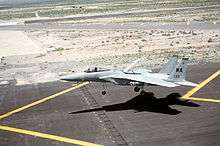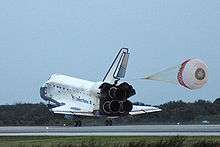Air brake (aeronautics)


In aeronautics, air brakes or speedbrakes are a type of flight control surfaces used on an aircraft to increase drag or increase the angle of approach during landing. Air brakes differ from spoilers in that air brakes are designed to increase drag while making little change to lift, whereas spoilers reduce the lift-to-drag ratio and require a higher angle of attack to maintain lift, resulting in a higher stall speed.
The earliest known air brake was developed in 1931 and deployed on the wing support struts.[1] Not long after, air brakes located on the bottom of the wing's trailing edge were developed and became the standard type of aircraft air brake for decades.
In 1936, Hans Jacobs developed self-operating dive brakes, on the upper and lower surface of each wing, for gliders.[2]:108Most early gliders were equipped with spoilers on the wings in order to adjust their angle of descent during approach to landing. More modern gliders use airbrakes which may spoil lift as well as increase drag, dependent on where they are positioned.
Often, characteristics of both spoilers and air brakes are desirable and are combined - most modern airliner jets feature combined spoiler and air brake controls. On landing, the deployment of these spoilers ('lift dumpers') causes a dramatic loss of lift and hence the weight of the aircraft is transferred from the wings to the undercarriage, allowing the wheels to be mechanically braked with much less chance of skidding. In addition, the form drag created by the spoilers directly assists the braking effect. Reverse thrust is also used to help slow the aircraft after landing.
Virtually all jet powered aircraft have an air brake or, in the case of most airliners, lift spoilers that also act as air brakes. Propeller driven aircraft benefit from the natural braking effect of the propeller when the engine is throttled back, but jet powered aircraft have no such innate braking effect and must utilise air brakes to control descent speed. Many early jets used parachutes as air brakes on approach (Boeing B-47) or after landing (English Electric Lightning).
The Blackburn Buccaneer naval strike aircraft designed in the 1950s had a tail cone that was split and could be hydraulically opened to the sides to act as a variable air brake. It also helped to reduce the length of the aircraft in the confined space on an aircraft carrier.
The F-15 Eagle, Sukhoi Su-27 and other fighters have an air brake just behind the cockpit.

Split control surfaces
The deceleron is an aileron that functions normally in flight but can split in half such that the top half goes up as the bottom half goes down to brake. This technique was first used on the F-89 Scorpion and has since been used by Northrop on several aircraft, including the B-2 Spirit.

The space shuttle used a similar system. The vertically-split rudder opened in "clamshell" fashion on landing to act as a speed brake,[3] as shown in the accompanying photo.
See also
References
- ↑ "Air Brakes for Planes Greatly Reduce the Landing Speed". Popular Science: 18. January 1933. Retrieved 2012-10-25.
- ↑ Reitsch, H., 1955, The Sky My Kingdom, London: Biddles Limited, Guildford and King's Lynn, ISBN 1853672629
- ↑ "Space Shuttle Coordinate System – Vertical Tail". NASA. Retrieved 2012-10-25.
| Wikimedia Commons has media related to Air brakes (aircraft). |